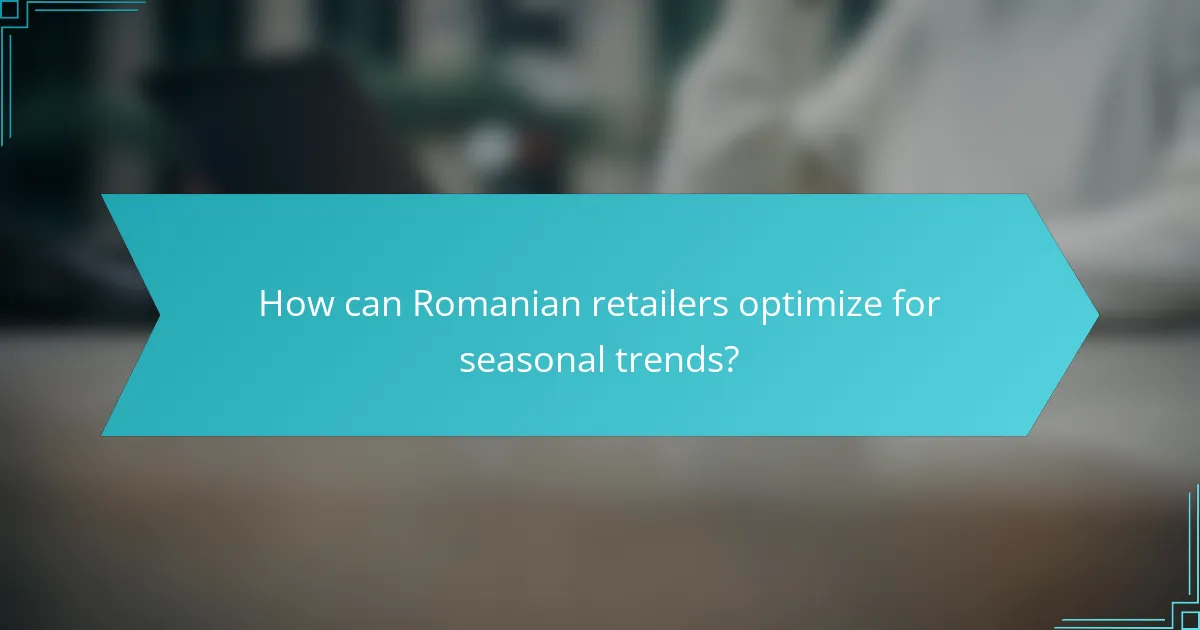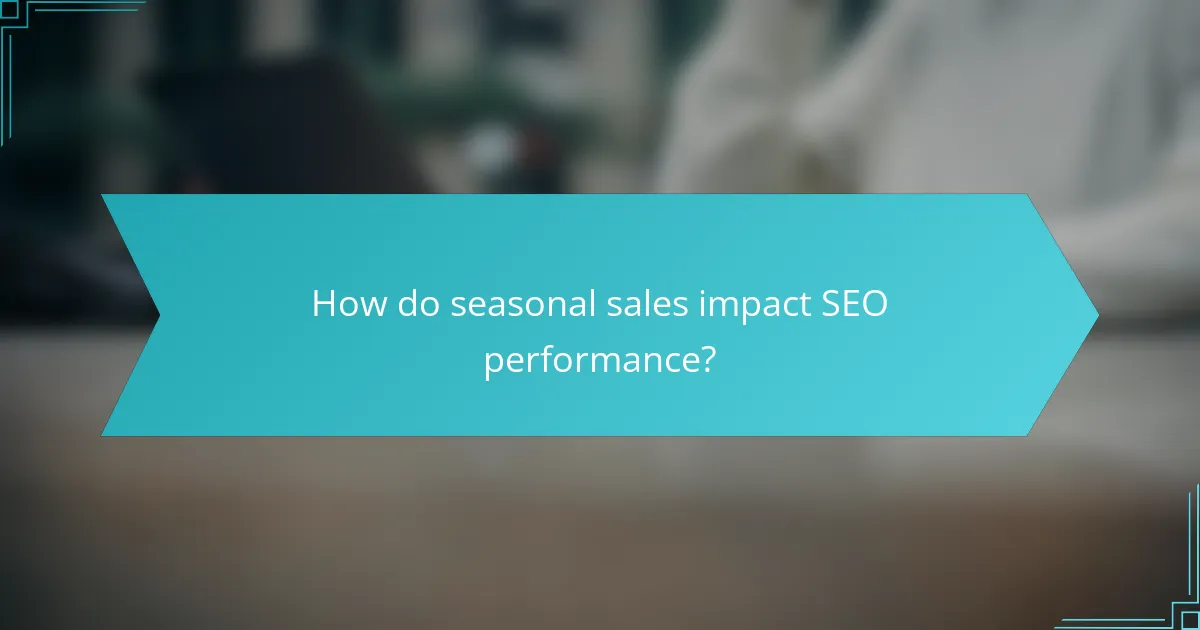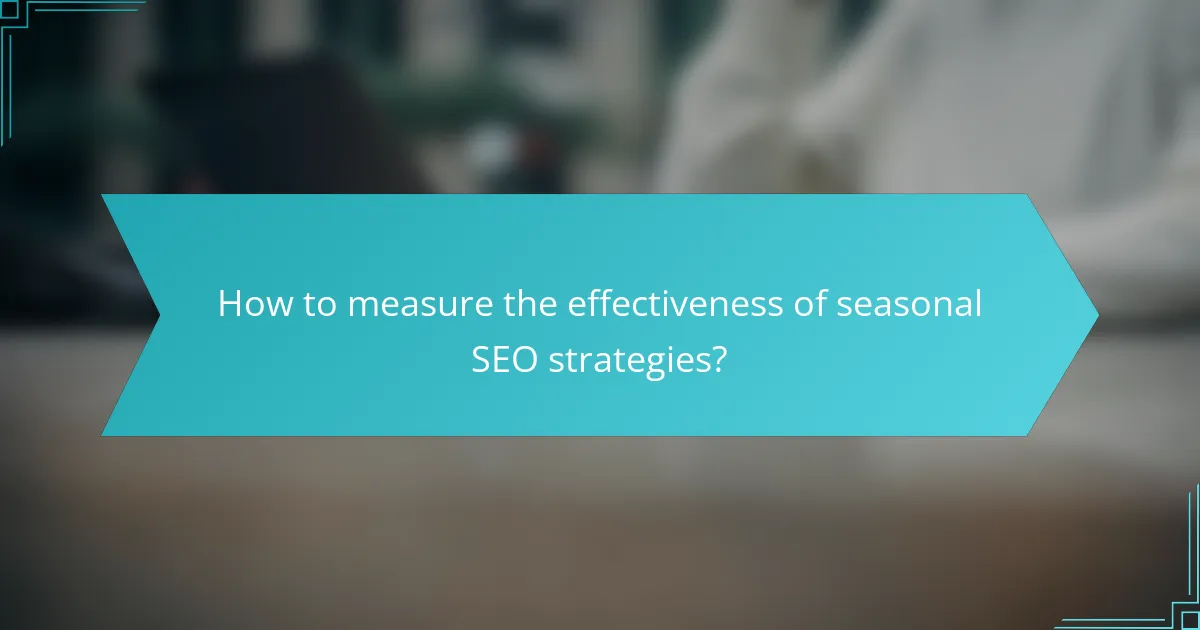Romanian retailers can significantly boost their online presence by implementing seasonal SEO strategies tailored to consumer behavior and market trends. By optimizing for local search, creating relevant content, and aligning inventory with demand, retailers can enhance visibility and drive sales during peak shopping periods. These tactics not only attract more customers but also improve overall SEO performance, making seasonal sales a vital component of a successful retail strategy.

How can Romanian retailers optimize for seasonal trends?
Romanian retailers can optimize for seasonal trends by analyzing consumer behavior, adjusting marketing strategies, and aligning inventory with demand fluctuations. Understanding these trends allows retailers to enhance visibility and drive sales during peak seasons.
Utilizing Google Trends for insights
Google Trends is a powerful tool that helps Romanian retailers identify what products or services are gaining interest during specific seasons. By entering relevant keywords, retailers can see search volume changes over time, allowing them to anticipate consumer needs.
To effectively use Google Trends, focus on keywords that relate to your products and monitor them regularly. This practice helps in identifying emerging trends and seasonal spikes, enabling timely marketing adjustments.
Implementing seasonal keyword strategies
Seasonal keyword strategies involve optimizing website content for terms that are relevant during specific times of the year. For example, using keywords like “Black Friday deals” or “summer fashion” can attract more traffic during those periods.
Retailers should conduct keyword research to find high-traffic seasonal terms and integrate them into product descriptions, blog posts, and meta tags. This approach enhances search engine visibility and can lead to increased sales.
Leveraging social media campaigns
Social media campaigns are essential for engaging customers during seasonal events. Romanian retailers can create targeted ads and organic posts that highlight seasonal promotions or new product lines, reaching a broader audience.
Utilizing platforms like Facebook and Instagram, retailers should tailor their content to reflect seasonal themes and encourage user interaction. Engaging visuals and timely posts can significantly boost brand awareness and customer loyalty.
Creating seasonal landing pages
Seasonal landing pages are dedicated web pages that focus on specific seasonal promotions or products. These pages can enhance user experience by providing relevant content and offers that align with seasonal trends.
When designing these pages, ensure they are visually appealing and optimized for mobile devices. Include clear calls to action and highlight any limited-time offers to encourage conversions.
Adapting inventory for seasonal demands
Adapting inventory to meet seasonal demands is crucial for maximizing sales. Romanian retailers should analyze past sales data to predict which products will be in high demand during specific seasons.
Implementing a flexible inventory management system can help retailers adjust stock levels based on seasonal trends. This approach minimizes overstock and stockouts, ensuring that popular items are available when customers are ready to purchase.

What are effective seasonal SEO tactics for Romanian retailers?
Effective seasonal SEO tactics for Romanian retailers include optimizing for local search, creating relevant seasonal content, and implementing schema markup for promotions. These strategies help attract more customers during peak shopping periods by enhancing visibility and engagement.
Focus on local SEO for holiday shopping
Local SEO is crucial for Romanian retailers during holiday shopping seasons. This involves optimizing your Google My Business listing, ensuring accurate NAP (Name, Address, Phone) information, and encouraging customer reviews. Targeting local keywords, such as “Black Friday deals in Bucharest,” can significantly improve your search rankings.
Consider creating location-specific landing pages that highlight seasonal offers and events. This not only boosts local relevance but also enhances user experience by providing tailored information for shoppers in different regions.
Incorporate seasonal content marketing
Seasonal content marketing helps engage customers by aligning your messaging with current trends and holidays. Create blog posts, social media campaigns, and email newsletters that focus on seasonal themes, such as gift guides for Christmas or summer sales. This content should resonate with your audience’s interests and shopping behaviors.
Utilize visuals and storytelling to make your content more appealing. For instance, share customer testimonials or showcase how your products can enhance holiday celebrations. Regularly updating your content can keep your audience engaged and improve your site’s SEO performance.
Use schema markup for seasonal promotions
Schema markup enhances your website’s visibility in search results by providing search engines with structured data about your seasonal promotions. Implementing schema for events, products, and offers can lead to rich snippets, which improve click-through rates. For example, marking up a holiday sale can display pricing, availability, and reviews directly in search results.
Ensure that your schema is up-to-date and accurately reflects your current promotions. Tools like Google’s Structured Data Testing Tool can help verify that your markup is correctly implemented. This attention to detail can give you a competitive edge during busy shopping seasons.

How do seasonal sales impact SEO performance?
Seasonal sales significantly enhance SEO performance by driving increased traffic and improving visibility during peak shopping periods. Retailers can leverage these sales to optimize their online presence, attracting more visitors and potential customers.
Increased traffic during holiday seasons
During holiday seasons, retailers often experience a surge in website traffic as consumers actively search for deals and promotions. This increased interest can lead to higher rankings in search engine results, as search engines prioritize relevant content that aligns with user intent.
To capitalize on this traffic, retailers should optimize their websites with seasonal keywords and create targeted landing pages. For example, using terms like “Black Friday deals” or “Christmas discounts” can help attract more visitors looking for specific offers.
Boost in conversion rates
Seasonal sales not only attract more visitors but also tend to boost conversion rates. Shoppers are often more willing to make purchases during promotional periods, especially when they perceive significant savings.
Retailers can enhance conversion rates by ensuring a seamless shopping experience. This includes optimizing product pages, simplifying the checkout process, and offering limited-time promotions to create urgency. For instance, highlighting a “20% off until midnight” can encourage quicker buying decisions.
Long-term brand visibility benefits
Engaging in seasonal sales can lead to long-term brand visibility benefits by establishing a retailer’s presence in the market. Consistent participation in seasonal promotions helps build brand recognition and loyalty among consumers.
To maximize these benefits, retailers should focus on creating high-quality content that resonates with their audience. This could include blog posts about holiday shopping tips or social media campaigns that showcase seasonal products. Over time, this strategy can enhance organic search rankings and foster customer loyalty.

What tools can Romanian retailers use for seasonal SEO?
Romanian retailers can leverage various tools to enhance their seasonal SEO strategies, focusing on keyword research, backlink analysis, and performance tracking. Utilizing these tools effectively can help optimize online visibility and drive traffic during peak shopping periods.
SEMrush for keyword research
SEMrush is a powerful tool for Romanian retailers to identify relevant keywords for seasonal campaigns. By analyzing search volume and competition levels, retailers can select keywords that align with consumer interests during specific seasons, such as holidays or sales events.
To maximize its effectiveness, retailers should focus on long-tail keywords that reflect specific seasonal products or promotions. For example, using phrases like “summer clothing sales Romania” can attract targeted traffic looking for seasonal deals.
Ahrefs for backlink analysis
Ahrefs provides valuable insights into backlink profiles, which are crucial for improving domain authority and search rankings. Romanian retailers can use Ahrefs to analyze their competitors’ backlinks and identify potential link-building opportunities.
Retailers should aim to secure backlinks from local blogs, news sites, and influencers relevant to their niche. This not only boosts SEO but also enhances brand credibility during seasonal promotions.
Google Analytics for performance tracking
Google Analytics is essential for tracking the performance of seasonal SEO efforts. Retailers can monitor key metrics such as traffic sources, user behavior, and conversion rates to evaluate the effectiveness of their seasonal campaigns.
Setting up specific goals and conversion tracking can help retailers understand which seasonal strategies are yielding the best results. Regularly reviewing this data allows for timely adjustments to optimize ongoing campaigns and maximize sales potential.

What are the prerequisites for seasonal SEO success?
To achieve seasonal SEO success, retailers in Romania must understand their audience, plan content strategically, and optimize their websites for relevant seasonal keywords. These elements create a foundation for effective campaigns that resonate with consumers during peak shopping times.
Understanding target audience behavior
Understanding target audience behavior is crucial for tailoring seasonal SEO strategies. Retailers should analyze shopping patterns, preferences, and seasonal trends to align their content with consumer expectations. For instance, during holidays like Christmas or Black Friday, consumers often seek discounts and gift ideas.
Utilizing tools like Google Analytics and social media insights can provide valuable data on customer interactions and preferences. This information helps retailers create targeted campaigns that engage their audience effectively, increasing the chances of conversion.
Establishing a content calendar
A well-structured content calendar is essential for executing seasonal SEO strategies. It allows retailers to plan and schedule content around key dates and events, ensuring timely delivery of relevant information. For example, starting holiday promotions in early November can capture early shoppers.
When creating a content calendar, include important dates, promotional themes, and corresponding keywords. Regularly review and adjust the calendar based on performance metrics to optimize engagement and reach. This proactive approach helps retailers stay ahead of the competition and maximize seasonal opportunities.

How to measure the effectiveness of seasonal SEO strategies?
Measuring the effectiveness of seasonal SEO strategies involves analyzing key performance indicators such as organic traffic and conversion rates. By focusing on these metrics, retailers can assess how well their seasonal campaigns are performing and make necessary adjustments.
Tracking organic traffic changes
To track organic traffic changes, retailers should utilize tools like Google Analytics to monitor fluctuations in visitor numbers during seasonal campaigns. Comparing traffic data from similar periods in previous years can provide insights into growth or decline.
Look for trends in traffic sources, such as an increase in visitors from search engines or social media. A significant rise in organic traffic during a seasonal campaign may indicate successful SEO efforts, while stagnant or declining numbers could signal a need for strategy reassessment.
Analyzing conversion rates during campaigns
Analyzing conversion rates is crucial for understanding the effectiveness of seasonal SEO strategies. Retailers should calculate the percentage of visitors who complete a desired action, such as making a purchase or signing up for a newsletter, during the campaign period.
It’s helpful to set benchmarks based on past performance and industry standards. A notable increase in conversion rates during seasonal promotions can indicate that the SEO strategy is effectively attracting the right audience. Conversely, low conversion rates may suggest that while traffic is high, the website experience or product offerings need improvement.
